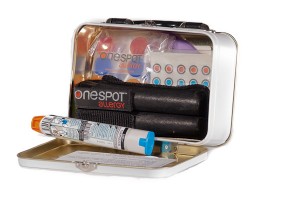I’m very pleased to share my interview with Elizabeth Goldenberg, President of Onespot Allergy, of onespotallergy.com, full of useful information on the topic of food allergies, food safety and children and much more.
Nowadays many people are faced with food allergies, and you provide an incredible website/service which helps people to avoid such allergens. What led you to create your site?
It’s true that many more people have food allergies these days. The most recent studies report that they affect five to ten percent of the population. I recently crunched the numbers for peanut and tree nut allergic individuals in the U.S., and the figure was 4,587,905 individuals.
I have two sons, and my younger son was diagnosed with allergies to peanuts and tree nuts in 2002 when he was two years old. I take things very seriously and I love to come up with custom solutions for everyday problems. After handling his allergy for one year, I realized that I’d created a system that kept him safe and prepared. I started my company in 2009 (once he was in school full time), and I now sell those safety products on http://www.onespotallergy.com.
Do you personally have any food allergies?
I don’t have any food allergies, and my husband and older son don’t either. I’m familiar with restricted diets, since I’m vegetarian and I don’t eat wheat, dairy, or sugar. Since my restrictions are based on personal choice, I don’t take the precautions to avoid all traces of those foods, which you need to take when you’re Celiac or food allergic.
I’m curious to know, how did the EpiPen come about? Was this your idea or did you work with another company/person to create this product?
The EpiPen auto-injector has been around for a long time. It was developed for the military to allow soldiers to inject themselves with medication to treat exposure to nerve agents. Although it’s a patented medical product, the inventor Sheldon Kaplan never received any royalties for his invention and lived a modest life. Smaller vanity auto-injectors are now coming on the market, but I don’t think they’ll be successful. People want to stay with what’s familiar to them, what emergency workers are trained to use, and what they trust. I’ll continue to use the EpiPen brand auto-injector. Please tell me about the EpiPen and how it works.
Please tell me about the EpiPen and how it works.
An EpiPen is an oval barreled cylinder with a super fine needle that slowly delivers adrenaline into muscle when the safety cap is removed and pressure is put on the tip. A severe allergic reaction (anaphylaxis) involves either a severe drop in blood pressure or the failure of two or more organ systems.
It’s adrenaline that helps stabilize a person having a severe allergic reaction by increasing blood pressure, and supporting the heart beat and lung function. Many people are familiar with adrenaline’s use with people who are being revived after a heart attack.
Can you share any life-saving stories regarding the EpiPen that customers have shared with you?
The best time to use the EpiPen is within five minutes of the start of a reaction. I have heard first hand that using one can provide immediate relief. It’s still essential to go directly to the emergency room after using an EpiPen, since it’s not necessarily the end of the allergic episode. The medication works for only 20 minutes, and more doses or other medications may be required to stop the reaction. Anyone who has needed to use an EpiPen tells me that they lost all fear of it, since the relief from their reaction was so profound.
What are the contents of the food allergy safety kit and how does it benefit the consumer?
I think of my safety products in three categories: EpiPen accessories, training materials, and allergen avoidance products. I make allergy safety videos explaining each product, and my complete allergy safety video library is on my home page www.onespotallergy.com and individual videos are also loaded onto my product pages.
If all of the products in the safety kit are used, you have in my opinion a complete system for living safely with food allergies. Below you will find a photo of the food allergy safety kit which includes:
- The customer’s choice of EpiPen belt or holster for wearing one or two EpiPens. I also sell belts for Twinject users (another brand of injector). This is to be worn at all times when away from home.
- A super strong magnetic hook to hold your belt in a designated location when you’re not wearing it. I compare your EpiPen to your fire extinguisher or first aid kit: You need to know where it is when you need it, not run around looking for it.
- An EpiPen training pen. This works like a real injector, but doesn’t contain the needle or medication. You use it over and over to show others how to deliver life saving medication, and to teach allergic individuals how to do it themselves.
- An allergy safety training video which includes a segment on using an EpiPen or Twinject injector properly.
- My emergency protocol and 911 script card and the following three tools to avoid exposure by cross-contamination:
- Color coded food allergy labels to mark items (water bottle, lunch kit, table setting) for the allergic person’s use only.
- Color coded towel clips to mark bathroom towels and dish towels for the allergic person’s use only.
- A single brush toothbrush holder. This may sound odd, but the bathroom is a huge source of cross contamination both of germs and food allergens. Anyone avoiding all traces of a particular food should store their toothbrush away from anyone else’s brush.
- A tin storage kit for keeping everything together.
I also sell a basic allergy safety kit, for people allergic to bees, medication, latex, or anything else. It contains everything but the last three products I mentioned.
I just sent a food allergy safety kit to a woman whose son was just diagnosed with food allergies. She joined my Facebook group too http://www.facebook.com/OnespotAllergy and now has all the products she needs to be prepared plus access to a world wide community of people sharing their knowledge and experience.
Being that I’m Celiac, I’m interested to know if your products also assist those who are allergic to gluten? Please elaborate on which ones are applicable to Celiacs.
People who are Celiac may be interested in my avoidance products, specifically the labels and towel clips. Since the gluten-free and food allergic communities overlap, I post articles on my Facebook page about gluten free living from time to time too.
I see that you also carry an organic lip balm that is free of allergens. What are some of the common allergens that are usually in most lip balms?
My lip balm is peanut oil and tree nut oil free. It’s common to find sweet almond oil or shea butter in lip balm, lotions, and cosmetics. I obtained the material safety data sheet to verify the source of the tocopherols in the lip balm, since they’re sometimes derived from soy, another allergen. One member of my food allergy community on Facebook pointed out that beeswax can have corn allergens in it, since bees are often fed corn syrup to get through the winter. There’s a lot to think about with food allergies, even when it comes to cosmetics.
Do you have a food-allergy friendly recipe that you can share?
I have a nice breakfast cookie recipe that my kids love. If you’d like to do a gluten-free version, I’d love you to share it with me. I make amazing crème caramel and brownies (the best you’ve ever tasted), but those recipes are top secret.
What is your favorite overall food-allergy friendly cookbook that you’d like to recommend?
I think Cybele Pascal has a wonderful bakers’ handbook, and she’s doing a great job sharing information about allergen free gluten free baking. I don’t have a copy of it yet, but she posts her recipes from time to time, and a lot of them look wonderful.
Please tell me about the food-allergy friendly placemats.
So many people browse the placemats! It’s important for people with food allergies to eat off an allergen-free surface, and you never know what was on a table before you sat down. I carry wipes to clean the table, but that can be awkward in someone’s home (imagine sitting down at your mother-in-law’s home and asking if you can wipe down the table). One way to ensure a clean surface is to bring a placemat along. I found one that’s reusable, completely non-toxic, and it rolls up to fit in a diaper bag. I’m going to find a version that’s suitable for older children.
In addition to your website, are your products available via doctors or medical professionals as well as drugstores?
Right now, my products are only available online or by calling my company. I’m refining the product line, and including some wholesale products. One day I’d like to see my products in drug stores, but that’s a little while away. I network with doctors, since my site is the best place to send their allergic patients for safety products, safety tips, and personal support.
How might customers in the US obtain your products? Out of the US?
About half of my customers are in the US, and the rest are in Canada. United States customers hit the US flag in the top right corner of my site to pay in U.S. funds. Clicking the Canadian flag takes you to my .ca site, where transactions are processed in Canadian funds. I ship throughout North America for $9.95 or less. I’m happy to ship anywhere else in the world at cost, and I do have a repeat customer in the U.K..
This leads me to another question, do insurance providers cover the costs of the food allergy safety kit or EpiPens?
EpiPens are covered by medical insurance usually. I also keep the receipts and claim any uncovered portion when I file my tax return. Unfortunately the safety products aren’t covered by insurance. I’d ask an accountant before making a deduction at tax time, but it may be possible to deduct them as medical expenses.
Through your OneSpotAllergy.com marketing efforts, do you ever visit with schools and/or school conferences or trade shows to enlighten about your products?
I do share my safety tips and products with schools and child care facilities. I also display at carefully selected events. I’m interested not only in reaching the food allergic population, but the greater community, to help build more awareness and understanding.
I’m booked to address a conference in October for home child care providers, and I’m donating my time. I reach a lot of people directly through Facebook and Twitter, where I post constantly about allergy safety.
What does the future hold for OneSpotAllergy.com?
The future looks great for Onespot Allergy! The company is now in its second year, and sales are growing. I’m looking into refining and expanding the medication belt category. Some very significant companies have noticed me, and we’re looking at how we can support each other’s businesses. I’m adding non-perishable allergy-friendly food to my product line and travel accessories. I’ll also continue to develop my role as a food allergy safety expert and advocate, and I plan to consult with businesses wishing to break into this market.
I noticed that you lend your opinions and reviews towards other products/books/services. On which products may one find a review by you?
I have been approached a few times to sample products, and when time allows, I’ll write a review. They’re usually food allergy related products, like a cook book, allergy safety cards, or a food product. It’s wonderful that people now come to me to test their products!
I can see that you’re a busy woman, what is the day of “Elizabeth Goldenberg” like?
I’m up very early to walk/feed the dog, hang out with my kids, make them breakfast and get them ready for the day. A lot of people assume that I work from home, but I actually have office space downtown, and I’m in the office from about 9:30 to 5 every day. Although I leave my office at 5, I’m online and available to customers until about 11 p.m., since people contact me from all over the world. I called one customer back only to learn that it was 12 hours later in her time zone, and I woke her up at 3 a.m..
Some days, my focus is filling and shipping orders. Other days, I’m writing my blog, newsletter, or an article. I never know what’s coming in by phone or online, and I need to be very flexible and responsive. This week a newspaper columnist messaged me while I was at lunch. Once hour later, she’d conducted the interview, and the photographer met with me the next morning.
Do you have any other projects or activities in the works that you’d like to share?
I’m very involved in supporting the United States Department of Transportation’s proposal to eliminate peanut service from airlines. Flying with peanut or tree nut allergy is a very dangerous situation.
This is a role I never anticipated filling, but no one else was holding the torch, and I didn’t want the opportunity to be missed for this change to happen. My previous career as a lawyer really helped me understand the rules and legislation, and hopefully make some persuasive arguments.
I’d really appreciate it if your readers would visit the petition page and complete the 3 second signing process. On the right side of the petition page, there are buttons to share the petition by e-mail or Facebook with their friends and family. The petition can be found at: http://www.change.org/petitions/view/banning_peanuts_from_airlines.
And my final question is for YOU – if you could share any one thing broadly with others, what would that be?
Avoid your allergen completely, even in trace amounts. Wear your EpiPen on your body (rather than carrying it in a bag or keeping it nearby) and use it within 5 minutes of the start of a serious reaction. Practice emergency drills regularly. Delay costs lives.
Thank you Elizabeth!
Tina Turbin
From our home to yours, Tina Turbin
If you have any questions or suggestions just email me at Info (at) TinaTurbin (dot) com.










What a great interview! Seriously, Tina, your interviews are the best. There isn’t one question left unsaid. Once again I’m more informed and inspired by yet another woman who has made a huge difference in the world after suffering from problems she had to overcome on her own. Bravo to Ms. Goldenberg!
You really have to appreciate the internet as a pro-women place for us to communicate about what matters to us, earn income, and make a difference. I can’t believe how many stories I hear about women and moms who are able to turn their advocacy and painful experiences into a positive enterprise (for-profit or not-for-profit) on the internet. How inspiring!
Thanks so much for this informative interview. I remember a couple of decades ago when food allergies weren’t very well-known. I wonder how many children (and adults) must have suffered. On the other hand, I wonder if the prevalence of food allergies has increased though. I bet at the beginning of the last century there weren’t nearly as many, although that’s just my guess and not a scientific opinion, although I have read about how the prevalence of celiac disease is increasing and experts think this may have to do with the way grains are processed.
This was a fabulous read. I love that you choose people that I wouldn’t ordinarily get to hear from and in their own words. I often find that they’re a lot like me, but after their own experiences with food allergies, celiac disease, or what-have-you, they went a step further than me and decided to make a difference.
Breakfast cookies??? That sounds great! As long as it’s not full of sugar and has protein and fiber in it! I tell you what, it’s great at the time to eat a sugary breakfast but I always pay for it later! I usually have some plain yogurt and a couple pieces of gluten free turkey bacon before I eat a dessert-type item for breakfast. This helps stabilize my blood sugar level.